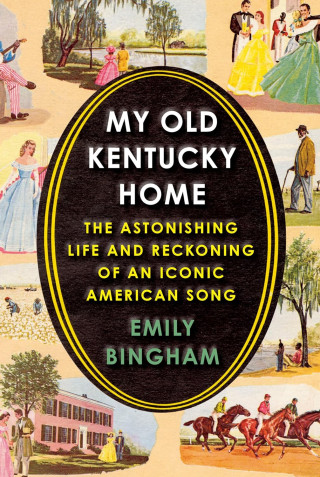I was not prepared for the mountain of material culture the song has generated. Objects bearing its stamp range from predictable postcards and generations of songbooks and sheet music to postage stamps, doorbells, bracelets, barware, garden flags, fried chicken boxes, duvet covers and throw pillows, and much, much more.
Yet “My Old Kentucky Home” was never just a pretty song. It was from the outset a “touching” blackface minstrel tune, entertainment built on slavery and the trade in human beings. It says a great deal about this nation’s ability to ignore uncomfortable aspects of its history that this same song offered white Americans a soothing and sentimental cocktail generically evoking old times, papering over the realities of slavery and Jim Crow. Over the decades, “My Old Kentucky Home” became a kind of sonic monument—white America’s song to itself.
Music enters us, becomes part of our breath, and this song is sung en masse each year at the Kentucky Derby by 150,000-plus spectators. It brings nostalgic tears to millions of eyes. It rings out on state occasions and at University of Kentucky basketball and football games (which many here equate with statewide occasions). Over the years, I have grappled with the ways this haunted melody became ensconced in actual homes, morphing onto things that were touched and held close, ornaments caressed by countless hands and eyes and lips. These objects may seem banal, but I believe they too make deep impressions.
The pages of a nonfiction book can’t convey the material emanations from Foster’s song over 170 years. They could fill a small museum, and perhaps some institution will undertake an exhibition. But I wonder: what is missed when the story of “My Old Kentucky Home” is told without accounting for its physical manifestation in everyday lives and its potent presence in the consumer culture? How has the song’s meaning been shaped by the way it has been acquired, possessed, collected, and worn?
My Old Kentucky Home” economics began with twenty-five-year-old Stephen Foster—America’s first professional songwriter—being paid two pennies (about eight percent) as a royalty on each copy of official sheet music of “My Old Kentucky Home” that was sold. (Nobody could control the myriad pirated editions.) Scholars estimate nearly 70,000 copies of the song were bought in the first decade, but that was not enough to keep him afloat. Foster died in 1863, age thirty-seven, in New York’s Bellevue Hospital with thirty-eight cents to his name. Of course, his New York publishers made a great deal more money off the song, as did the blackface minstrels, whom one critic dubbed “the songbirds” who used it to entertain audiences across the country and the globe.
